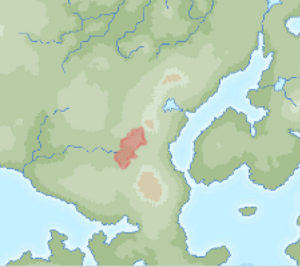Ghobari Valley Civilisation
 Map of believed extent of the Ghobari Valley Civilisation | |
| Alternative names | Ghōbārī Upatyakā Sabhyatā |
|---|---|
| Geographical range | Amutia |
| Period | 6,900s BCE – ca. 3,400s BCE |
| Type site | Ghobari Valley |
| Major sites | Purghur |
| Followed by | |
The Ghobari Valley Civilisation (GVC), also known as the Ghobari Civilisation, was an ancient civilisation that existed in the Ghobari Valley of Mahana and Mekabiri from around 7,000 BCE to 3,400 BCE. It was one of Europa's earliest known civilisations and Orient's oldest.
Name
The Ghobari Valley Civilisation's name comes from the location they were first discovered, the Ghobari Valley. It is unknown how the people who lived here called themselves. No markings or inscriptions were found. The site is dated far before the invention of the first writing systems.
Extent
The civilisation stretched from the southernmost point of the Samripe Mountain Range to northern Mekabiri. At that time in the past, the climate was quite different. The Amutian desert had just begun to expand and swallow up the previously green savannah. Over the period of several millennia, Amutia became a much drier place. The Ghobari Valley remained a rare, fertile oasis of life. It shielded people and animals from the encroaching desert. In this isolated pocket, the unique GVC formed. The present-day dry climate helped preserve their remains and traces.
Discovery
The first reports of the civilisation date to the 1820s. In 1822 an excavation group lead by Danvanth Raji (1788-1833) discovered ruins in the Ghobari Valley of Mahana. Raji would later go on to discover might more. He continued expanding the site for over a decade until his unfortunate death.